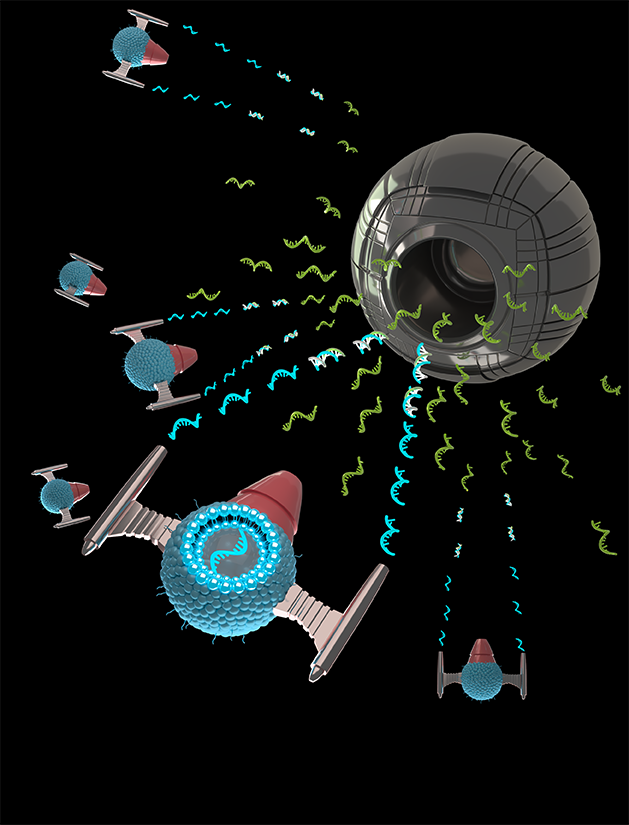Journey to the Center of the Cell
Scientific Journal Cover
3D modelling, Editorial, Molecular
Description
This editorial cover was designed for a mock scientific publication called ‘Science Visualized’. The aim of the project was to create a journal cover that described the core ideas of a research article using a visual metaphor.
The research paper described the use of lipid polymer nanoparticles to transport peptide nucleic acid (PNA) to the cytosol of epithelial cells as a form of gene therapy to treat cystic fibrosis. The visual metaphor used was a space battle, where ‘hero’ nanoparticle ships shoot PNA at the ‘enemy’ ship, the nucleus, which is generating disease causing miRNA.
Note: The layout of text elements was a design constraint imposed by the editorial design.
Year
2022
Tools
Autodesk Maya, Adobe Photoshop, Adobe Illustrator
Media
Print- editorial cover
Client
Stuart Jantzen
Audience
Educated lay audience
Process
First, key concepts were extracted from the source paper and organized by topic. These concepts were then distilled into core ideas and an overall synopsis of the research.
INITIAL BRAINSTORM
ORGANIZED BRAINSTORM
Next, thumbnails exploring two different visual metaphors were created and presented to peers. There was a consensus that the ‘space battle’ metaphor was the most effective at communicating the topic.
SPACE BATTLE - cHOSEN METAPHOR
Tank BATTLE - ALTERNATE METAPHOR
I then created a design comprehensive in Adobe Photoshop. I used this sketch to work out what assets were needed and how they would be designed, arranged, textured, coloured, and lit. I additionally included elements that would be added in post-production, such as stars.
DESIGN COMPREHENSIVE
I then modelled each asset in Autodesk Maya. Elements were created using a combination of hard- surface modelling, MASH networks, and animated sequences baked into geometry.
Each model was assigned a material and lit. Foreground, midground, and background elements were rendered individually and composited using Adobe Photoshop.
FINISHED MODELS
COMPOSITED RENDERS
Next, the image was edited and additional elements were added in post-processing. Adobe Photoshop was used for this step.
POST-PROCESSED IMAGE
Lastly, text elements were added to the scene using Adobe Illustrator.
FINAL IMAGE
References
Source Article:
Comegna, M., Conte, G., Falanga, A. P., Marzano, M., Cernera, G., Di Lullo, A. M., Amato, F., Borbone, N., D’Errico, S., Ungaro, F., d’Angelo, I., Oliviero, G., & Castaldo, G. (2021). Assisting PNA transport through cystic fibrosis human airway epithelia with biodegradable hybrid lipid-polymer nanoparticles. Sci Rep, 11, 6393:2021. https://doi.org/10.1038/s41598-021-85549-z
Image References:
Chen, C., Sun, J., Chen, S., Liu, Y., Zhu, S., Wang, Z., Chang, S. (2019). A multifunctional-targeted nanoagent for dual-mode image-guided therapeutic effects on ovarian cancer cells. International Journal of Nanomedicine, 14, 753-769. https://doi.org/10.2147/IJN.S187929
Hadinoto, K., Sundaresan, A., Cheow, W. S. (2013). Lipid-polymer hybrid nanoparticles as a new generation therapeutic delivery platform: A review. European Journal of Pharmaceutics and Biopharmaceutics, 83(3A), 427-443. https://doi.org/10.1016/j.ejpb.2013.07.002
Sabale, P. M., Ambi, U. B., & Srivatsan, S. G. (2018). Clickable PNA probes for imaging human telomeres and poly(A) RNAs. ACS Omega, 3(11), 15343-15352. https://doi.org/10.1021/acsomega.8b02550
Sadik, O. (2017). The two faces of nanotechnology: concern about toxicity of nanoparticles is balanced by the potential of nanomedicine. American Scientist, 105(4), 208. https://doi.org/10.1511/2017.105.4.208









